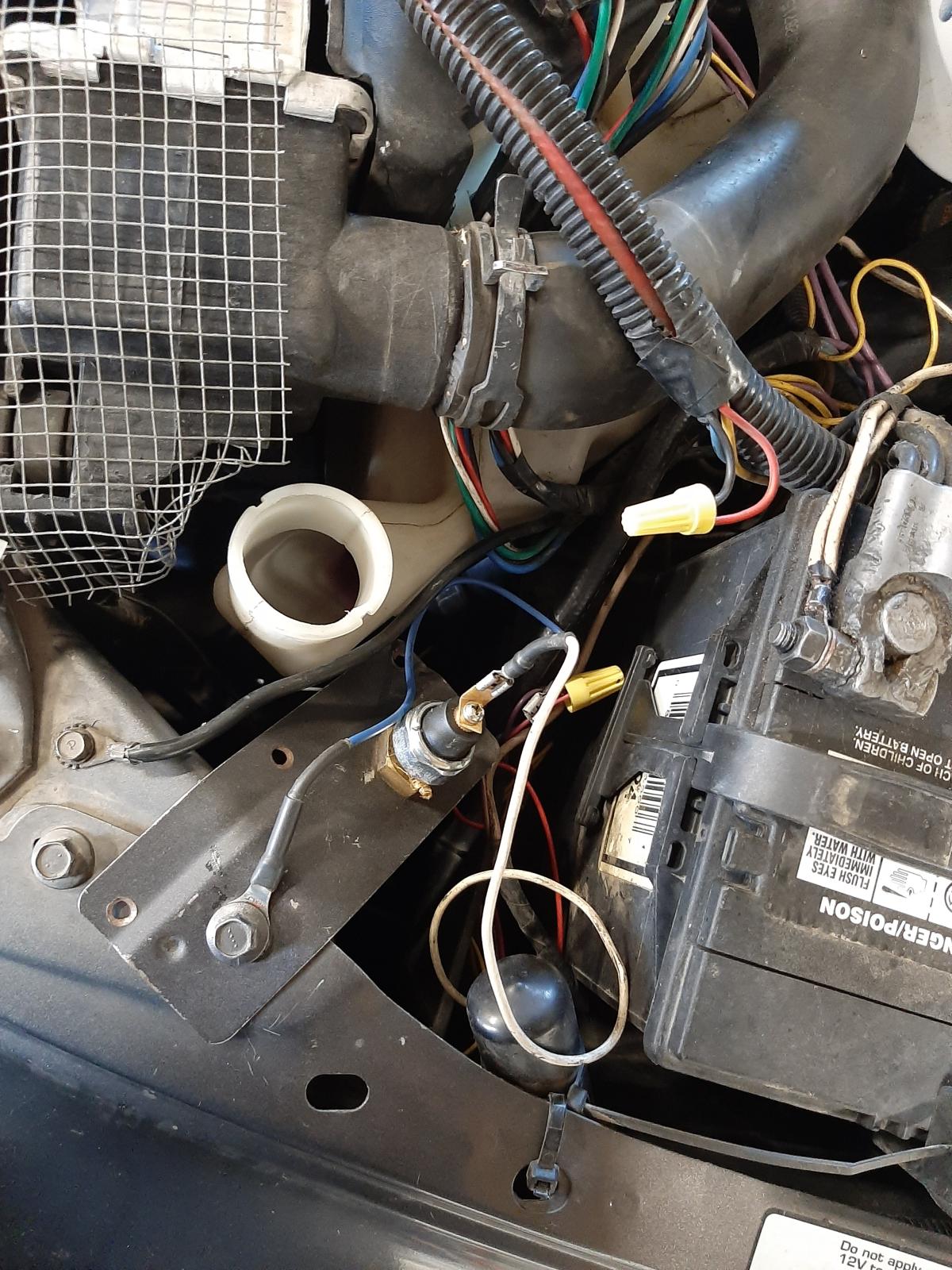
-
Yoke Grenaded
Had you noticed any driveline vibration or noise prior to the event? Had the driveline been removed and re-installed recently? Was the rear u-joint still in good operating condition disregarding the damage from the end yoke failure? In other words, were the end caps lubed, not dry? How do you use this truck? Does it do any sled pulling? burnouts? I only ask these questions just to cover anything that may generate shock loads to the drivetrain. Personally, I would just replace the parts needed with the OEM style end yoke. After seeing what happened with your truck, I think I will inspect the end yoke on my truck. - John
-
Yoke Grenaded
Looks like a U-bolt style was used on the 2nd generation 3500's, but not the 2500's. I think the U-joints are a 1410 series on a U-bolt style. A conversion would be possible, but probably costly. Did you do a failure analysis to determine whether it was an instant failure, or one that was coming on slowly? The photo doesn't show all of the broken area, so it is hard to tell if there was a crack first, then a breakaway. As far as I know, the OEM type end yoke is not problem connection. - John
-
Tractorman started following Yoke Grenaded
-
Working through miss/studder issues - codes 0237 & 0230
Thanks for posting video. That is definitely all cylinders cutting out - like the fuel is briefly shut off intermittently. I watched your video a few times. Couple of questions. Just before the first cut out, your tach increased in RPM's. Was that you pressing the throttle or did that happen on its own? Can you make it happen? If so, exactly how do you make it happen? We gotta get this fixed! John
-
Working through miss/studder issues - codes 0237 & 0230
The concern is with his varying battery voltage at the injection pump (not the ECM), which has been demonstrated in his graph. The graph below his first graph. His most recent graph has improved, but is still unstable. Do you have the capability to produce a graph on your truck to show what battery voltage should like at the injection pump? John
-
Working through miss/studder issues - codes 0237 & 0230
I apologize for not getting back to you yesterday. I had some emergency roof repairs to do as a result of an overnight wind storm. I did try my scanner late in the day, but apparently my scanner is not capable of reading battery voltage at the fuel injection pump. @Mopar1973Man , can you perform this test on your truck? John
-
Working through miss/studder issues - codes 0237 & 0230
I think the wires that you are referring to are for the fuel heater and water-in-fuel sensor. You may set a code if they are disconnected, but I don't think it will affect driveability. I think you are on track with verifying good electrical connections between the battery, the ECM, and the PSG on the VP44. "Volt Drop" + "Injection Pump Battery Voltage" seems to equal 14.00 volts, give or take a couple of hundredths on your graph of over 800 reading covering a 10 minute span. On some readings where the voltage is low (10.9 for example) adding the "Volt Drop" doesn't bring it to the 14.00 volt value. This could be because there is a split second recording delay from one reading to the other. I have a scanner, but I don't know if it will display voltage at the injection pump. I will give it a test tomorrow. John
-
Working through miss/studder issues - codes 0237 & 0230
The 12 valve engine ('94-'98) uses a P7100 injection pump - no electronics. The Gen3 engine (starting in '03) uses a common rail fuel injection system. The only comparison engine that would work for you to test would be in a VP44 truck ('98.5-'02). If a single cylinder is misfiring, it would feel similar to a gasoline spark ignition six cylinder engine misfiring on a single cylinder - such as a spark plug misfiring. The misfire in your engine would feel stronger as more engine throttle and load were applied, whether or not it is a random cylinder or all cylinders. I suspect that it is all cylinders if it very jerky under power. The fuel solenoid inside a VP44 injection pump fires every cylinder, so if its electrical power source is temporarily interrupted, all cylinders will be affected until electrical power is restored. John
-
Working through miss/studder issues - codes 0237 & 0230
I have never done the type of testing that you are doing, so I don't any experience here. But, it would be good to see the same tests performed on a good running VP44 truck and compare the results. Is that possible for you to do? Is the bottom horizontal scale "time in milliseconds"? When the engine cuts out, does it feel like is a random cylinder misfiring, or does it feel like all injectors quit firing briefly? John
-
Working through miss/studder issues - codes 0237 & 0230
APPS (accelerator pedal position sensor) on the Cummins. When the APPS becomes output signal becomes intermittent as it ages, a specific code is usually set and the engine typically goes right to idle - referred to as "dead pedal". The dead pedal lasts for about 10 seconds or so, then goes back to normal until the next event. The photo below is from one of your earlier posts. I would be specifically concerned with re-checking the voltage to the injection pump. Voltage falling down to 9.5 volts could easily cause intermittent operation of the fuel solenoid valve in the injection pump resulting in random injection events not happening. This does match your symptoms. John John
-
Working through miss/studder issues - codes 0237 & 0230
I re-read all of your posts. Do you still get voltage fluctuations at the injection pump, especially under acceleration? If so, those low voltage readings on your original graph could cause the fuel solenoid to misfire. Something that has not been discussed is fuel supply. If the injection pump is continuously getting the proper voltage, then maybe the fuel supply is inadequate during hard accelerations. Do you have an operational fuel pressure gauge in the cab? John
-
Working through miss/studder issues - codes 0237 & 0230
Yes. The 140 amp fuse is reliable. It is not used on the passenger side battery because it has no fuse holder. People typically buy a 150 amp fuse (with holder) of their choice to use on the passenger side battery. I have changed mine to this setup three years and 35,000 miles ago. It has been working fine. John
-
Edge Juice with Attitude Fuel Pressure Sensor
I recommend mounting the pressure switch remotely. Make the connection with an 18" or 24" grease hose (1/8" NPT both ends) in conjunction with a snubber. Use a bulkhead fitting (from Amazon) for the remote location. Make sure there is at least a 90° bend, or make a complete loop with the grease hose. This reduces pressure spikes to the sensor. A remote location gives you easy access for testing fuel pressure or replacing the pressure switch. The photo below shows my earlier installation before I purchased the LEFOO LF20 pressure switch. John
-
Edge Juice with Attitude Fuel Pressure Sensor
Absolutely. Reading the following may help you feel more at ease: I have owned my truck since new and it currently has logged 402,000 miles on the odometer. Odometer 66,000 miles August 2004 - First injection pump set a code P0216 ( a death code for the VP44). Odometer 87,000 miles August 2005 - Injection pump replaced with re-manufactured unit under warranty. Lift pump relocated as an in-tank pump application (also covered under warranty). Just prior to replacing VP44 injection pump, I monitored lift pump pressure because the word back then (similar to what is now) was that if you don't have 14 psi lift pump pressure, you are going to kill the VP44. So, I drove my truck for a week (250 miles) monitoring lift pump pressure. It operated within factory specs flawlessly and maintained 6 psi at wide open throttle at 2500 rpm. After the replacement of the VP44 injection pump and the replacement / relocation of the lift pump as an in-tank lift pump, my new lift pump pressure was 6 psi at idle and 3 psi at wide open throttle - yes, 6 psi and 3 psi! I was not concerned because by then I had learned much about the true operation of the VP44 fuel system. According to all of the diesel forums, I should have mutilated the VP44. But, that didn't happen..., and it still hasn't happened. Odometer 250,000 miles April 2016 - Install Smarty tuner and set for mild tune. Odometer 251,000 miles April 2016 - Replace in-tank lift pump (not because of failure, but to have more readily serviceable frame mounted used FASS lift (65 gph). Note that the re-manufactured VP44 has logged 164,000 miles with maximum fuel pressure at 6 psi. Should be dead now, right? But, alas, it isn't. FASS lift pump - 12 psi at idle, 6 psi WOT at 2,000 rpm Odometer 303,000 miles December 2018 - Replace original injectors with RV 275's Odometer 402,000 miles - November 2025 - Now have logged 315,000 miles on re-manufacture VP44. Should be dead by now - right? But, again, it isn't. I would like to note that this truck has never received fuel additives, nor 2-stroke oil to the fuel. Also, I would like to note that this truck has done lots of work covering thousands of miles at 20,000 lbs gross combined weight crossing lots of mountain passes in hot summer conditions. Hope this helps. John
-
Edge Juice with Attitude Fuel Pressure Sensor
It is true that the overflow valve is regulated at 14 psi. However, this pressure (and the fuel return flow provided) has no correlation to lift pump pressure. Your statement here is misleading. I do agree that the overflow valve will be closed when fuel pressure that the overflow valve senses falls below 14 psi. However, the fuel pressure that the overflow valve senses is provided from the flow of the VP44's internal fixed displacement vane pump, not the lift pump. Consequently, the volume of return fuel through the overflow valve is the same for a given engine rpm and load whether lift pump pressure is 5 psi or 20 psi. The VP44's internal fixed displacement vane pump's flow is regulated to well above 100 psi. This is why the 14 psi overflow valve opens immediately when the engine is started. It never closes until the engine is shut off - regardless of lift pump pressure. Since the lift pump and the VP44's internal fixed displacement vane pump are plumbed in a series circuit, the volume of the the internal vane pump cannot be changed by lift pump pressure. The volume can only be changed by changing engine rpm. In the past I have posted the results of extensive testing by others (using a flow meter in the fuel return circuit) that clearly supports what I am saying here. This testing was performed in April of 2001 (before any of us even owned our trucks) by a few Turbo Diesel Register members. About three years ago I performed similar tests, as well. The results showed that fuel return flow remained the same, even when the lift pump was turned off and bypassed. I post this information in hoping to give a better understanding of the relationship between the lift pump, the internal vane pump, and the overflow valve operation in the overall VP44 fuel pump injection operating system. John
-
Edge Juice with Attitude Fuel Pressure Sensor
Any particular reason you don't want your lift pump to fall below 14 psi? You could plumb in a tee right at the injection pump fitting just for your test gauge. John







